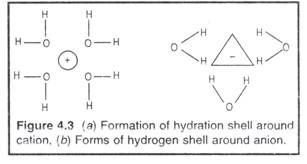ADVERTISEMENTS:
1. Water is highly cohesive and adhesive:
Because of hydrogen bonds, water molecules develop strong intermolecular attraction between them. This is called cohesion.
When water form hydrogen bonds with other substance, the attraction is called adhesion. Due to cohesion and adhesion, seeds swell and germinate; ascent of sap and capillary movement of water takes place.
ADVERTISEMENTS:
2. Water has high tension:
This is due to cohesion of water molecules. Due to this property, small organism float or walk on water surface.
3. Water has high specific heat and high heat of Vaporization:
Both of these properties are due to requirement of more energy to break hydrogen bonds. Specific heat means the amount of heat absorbed or lost by 1 gm. of substance to change its temperature by 1°C. The specific heat of water is high (1 calorie/gm/°C). This property ensures slow heating of water; maintain constant temperature of living organisms and environment.
ADVERTISEMENTS:
Water has high heat of vaporization (540 cal gm. -1) i.e. about 540 cal heat required to change 1 gm of liquid water into gas. Thus, evaporation of water from a surface removes excess heat energy. This causes cooling effect of leaves, remove body heat through sweating and protect organism from thermal shock.
4. Water has high boiling point and high thermal conductivity:
Because of these properties water store and spreads heat and prevent from overheating
5. Water has high heat of fusion:
Water requires a loss of lot of heat to freeze. This prevents freezing and ice formation in the protoplasm even when exposed to very low temperature.
6. Water has lower density on freezing:
Water has maximum density at 4°C. But below 4°C water become less dense because they placed apart because of it so ice is less dense than liquid water and floats on surface water surface ice insulated the underwater film freezing and protect the aquatic life.
7. Water is transparent:
This allows light to penetrate 200mt depth in sea and lakes. So plants carry on photosynthesis under submerged conditions.
ADVERTISEMENTS:
8. Water has high dielectric constant:
This opposes the attraction of opposite charges of ions. Because of this water acts as powerful solvent for salts and many non-ionizable organic molecules.
9. Water is incompressible:
It helps organisms to tolerate pressure and compression. Because of this in earthworm water acts as hydro skeleton. Loss or gain of water causes various plant movements like stomatal movement, seismonasty of Mimosa leaves etc.
ADVERTISEMENTS:
10. Water can ionize:
A small amount of water spontaneously dissociated into hydrogen ion (H+) and hydroxyl ion (OH–) which depends on temperature. This is called ionization.
H2O ⇋H+ OH–
At 25°C, out of 550 million water molecules, only one undergoes ionization. In water, H+ has no stable existence and occurs in association with another water molecule to form of hydronium ion (H3O+).
ADVERTISEMENTS:
H+H2O⇋ H3O+
In aqueous solutions, the concentration of H+ and OH- becomes the basis for the pH scale. At standard condition of temperature and pressure only 10-7 moles. It. of water molecules are dissociated. It means in pure water, the [H+] is 10-7 moles/liter.
Thus the pH of pure water is:
pH = – log [H+] = – log 10-7 = 7.0
ADVERTISEMENTS:
11. Water is a reagent:
In many biochemical reactions water is a source of H+ and OH”. During photolysis, water donates electron (e-) to chlorophyll and itself oxidized to molecular oxygen.
